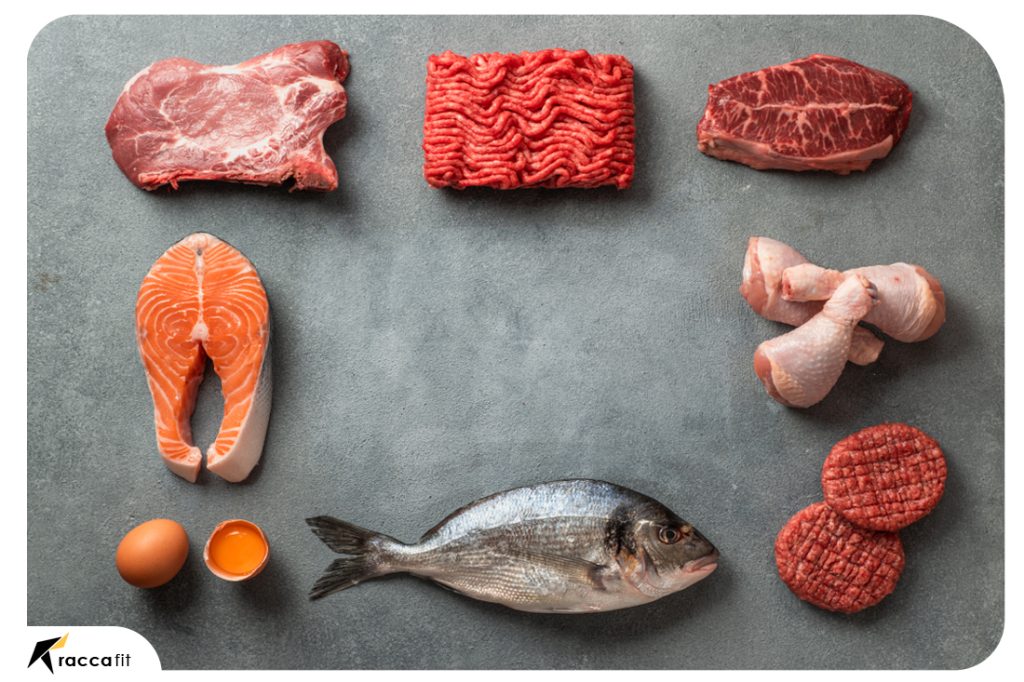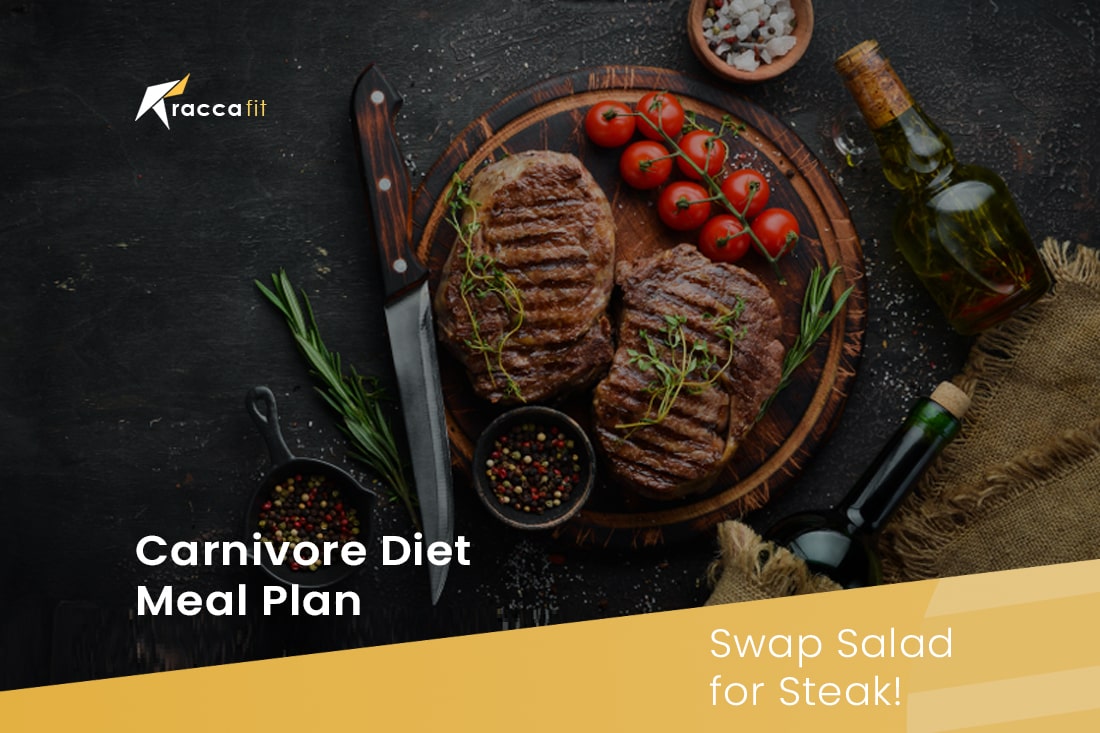Welcome to the enticing and somewhat controversial world of nutritional trends. Our protagonist today is the Carnivore Diet Meal Plan. This approach to eating, defined by its high-protein, zero-carb blueprint, has been turning heads in the nutrition and health circles, drawing both applause and critique.
To comprehend this topic area better before moving any further into detail Let’s acquaint ourselves with some basic principles regarding the subject matter at hand: The Carnivore Diet Meal Plan – Its foundation- involves recommending that followers only consume animal-derived food items such as certain meats (beef), poultry (chicken) or other protein sources found in eggs or dairy hence omitting non-animal based substances including the likes of fruit & veg — relegating these components more towards a supporting role rather than being front & centre of any meal preparation.
What is a Carnivore Diet Meal Plan?
The Carnivore Diet Meal Plan, in its essence, is a diet that comprises entirely of foods sourced from animals. We are discussing a multifaceted selection of sustenance which includes an array all the way from proteins like beef, pork or chicken to diverse varieties of seafood. Subsequently we have eggs available along with particular forms of dairy items which make it onto this list.
In a world teeming with dietary plans advocating a balance, the Carnivore Diet Meal Plan stands out starkly with its all-or-nothing approach. It’s noteworthy that while most diets argue over the proportions of food groups, the carnivore diet challenges the very presence of some. The role of carbohydrates in this situation is negligible, with proteins taking center stage and fats providing vital support.
Benefits of a Carnivore Diet Meal Plan
While at first glance, the carnivore diet might seem extreme, followers of this eating philosophy argue that the benefits are worth considering.
Weight Loss
Firstly, the carnivore diet is often hailed as an effective tool for weight loss. The primary reason is that protein, which would be the main component of your meals in this diet, is incredibly satiating. That means you feel full quicker and stay satisfied for longer, potentially leading to a lower caloric intake. Additionally when consumed protein triggers a significant thermic effect resulting in the burning of more calories for its digestion than both fats and carbohydrates.
Increased Protein Intake
This one is a no-brainer. When animal products comprise your entire diet it is prudent to recognise that this can lead to notable levels of protein consumption. This macro-nutrient is fundamental to various bodily functions, including muscle growth and repair, hormone production, and overall body maintenance.
Reduced Inflammation
Believers in the carnivore diet argue that eliminating plant foods can lead to reduced inflammation in the body. Some people may have sensitivities or intolerances to certain plant compounds, which may cause inflammation. By consuming only animal products, followers of the carnivore diet believe they can avoid this issue.

Common Foods on the Carnivore Diet Meal Plan
One might think that the carnivore diet, given its limitations, lacks variety. While it may be true that the selection of foods is somewhat limited. It should be noted that they possess a certain level of flexibility. From tender beef to juicy pork or succulent turkey and chicken; this menu still manages to offer diverse meat choices. Fish, too, holds a prized place, especially fatty varieties like salmon and mackerel that offer the added advantage of heart-healthy Omega-3 fatty acids. Eggs, with their perfect balance of proteins and fats, are also welcomed. Dairy is permitted, but generally limited to high-fat, low-carb options like butter, hard cheeses, and heavy cream.
How to Start a Carnivore Diet
Initiating a carnivore diet could potentially be a substantial shift for many, especially if you’re used to a balanced or plant-focused diet. However, here are two approaches that might help:
Gradual Transition
It might be more compassionate to gradually increase animal product intake while simultaneously reducing the consumption of plant-based foods as opposed to abrupt changes. By adopting this slow transition, it may ease your body and mind into adjustment. For instance, you might begin by eliminating fruits and sugars, followed by starchy vegetables and grains, and finally nuts and seeds.
Going Full Carnivore
For those seeking a challenge or a bold entrance, adopting a complete carnivore diet immediately may be a viable option. This method requires some mental preparedness as the shift in diet is quite drastic. Nevertheless, certain individuals prefer this method since it facilitates immediate implementation and assessment of the diet’s influence on their physical wellbeing.

A Sample One-Week Carnivore Diet Meal Plan
To help illustrate what the carnivore diet might look like in practice, here’s a sample one-week meal plan:
Day 1 to Day 7
Follow this kind of pattern, mixing and matching between different kinds of meats, fish, and eggs.
- Breakfast: Beef steak with eggs and a slice of cheese
- Lunch: Grilled chicken thighs with butter
- Dinner: Pan-seared salmon with a side of bone broth
Tips for Success on the Carnivore Diet Meal Plan
Success with the carnivore diet is about more than just sticking to animal products. It’s worth taking the time to consider the quality of the foods you consume on a regular basis. Making a conscious effort to seek out grass-fed meats, pasture-raised eggs/ poultry or primarily taking wild-caught fish on meal platters can offer numerous benefits when it comes down to overall health. Additionally such practices has potential in reducing environmental damage produced through unethical farming principles while promoting ethical raising/treatment portrayed through livestock welfare protocols supported by many! These generally have a better nutrient profile compared to their conventionally raised counterparts. Drink plenty of water to stay hydrated and facilitate digestion. Always be mindful of the fact that its’ crucial to listen carefully when your body speaks and make any necessary changes accordingly.
Learn More: Metabolic Confusion Diet Plan: A Metabolic Revolution
Potential Risks and Drawbacks of the Carnivore Diet Meal Plan
As with any restrictive diet, the carnivore diet comes with potential risks. Food choices play a major role in maintaining good health but excluding key food groups such as fruits, vegetables or whole grains from your regular meals could potentially lead to missing out on vital nutrients like Vitamin C , potassium or dietary fiber – an oversight any mindful eater would seek to avoid. Further down the line there is high evidence indicating negative implications caused by the consumption of large amounts of meat overtime . Long term effects include heightened risk for heart diseases,a leading cause death globally. And some variants cancer as warned by health professionals.
Misconceptions About the Carnivore Diet Meal Plan
Like most things that stray from the norm, the carnivore diet is subject to several myths and misconceptions that sometimes cloud people’s judgment.
Myth: The Carnivore Diet Meal Plan Causes Nutrient Deficiencies
A common fear surrounding the carnivore diet is that it will lead to nutrient deficiencies. Its’ understandable to have doubts about the efficacy of the carnivore diet upon initial inspection. After all, cutting out entire food groups that act as major sources for vital nutrients such as fiber or vitamins (like fruits or vegetables) may raise red flags initially.
However it is worth mentioning that a well rounded carnivore focused meal plan can still offer an excellent array of essential nutrients through animal derived products alone – especially with organ meats or shellfish in your regimen – both known to be incredibly nutrient dense examples. Take beef liver for instance: not only does it provide ample amounts for both Vitamin A & B category but oysters contain substantial quantities of zinc & b12 as well. Consuming a diverse range of animal products is essential for covering your nutritional bases on a carnivore diet.

Incorporating Exercise into the Carnivore Diet Meal Plan
For individuals looking to adopt a carnivore diet its’ important not to overlook the value of physical exercise in maintaining overall health and wellbeing.
How to Combine Resistance Training with the Carnivore Diet Meal Plan
The carnivore diet’s high protein content is beneficial for individuals who engage in resistance training. Protein is fundamental for muscle recovery and growth, and consuming enough of it can help optimize the results of your resistance training. For optimal physical fitness benefits, integrating a strength training schedule of three to four times per week using compound exercises like squats, deadlifts or bench presses that train several muscles at once is sound advice. Despite this advice being influential across the board of general health improvement enthusiasts its imperative not forget how unique each body may be with varying capacities restricting them from this recommendation . Consequently creating an individualized routine factors in the capability aspect along with aligning it according to specific health aspirations when it comes to selecting an effective personalized approach towards fitness success.
Carnivore Diet vs. Other Popular Diets
The dietary world is wide and varied. Let’s see how the carnivore diet compares to another popular eating plan: the ketogenic diet.
Carnivore Diet vs. Keto Diet
The ketogenic, or keto diet, shares similarities with the carnivore diet, most notably in their low-carb approach. Although their ultimate objective involves transitioning your body into ketosis – where fat becomes your primary energy source instead of glucose – both approaches share similarities. While minimizing carb consumption sets keto apart from other diets; that does not mean all plant based foods are completely prohibited. Instead nutrient dense items such as non starchy vegetables in conjunction with healthy fats sourced from avocados or olive oil remain fundamental staples within this eating pattern. Thus, the keto diet offers more variety and potentially a broader nutrient profile, but the carnivore diet can be simpler to follow due to its clear-cut rules.
Science Behind the Carnivore Diet Meal Plan
Though it may seem like another fad, there’s an intriguing science behind the carnivore diet.
The Role of Gluconeogenesis in the Carnivore Diet
In cases when dietary consumption of carbohydrates is limited or not an option at all our bodies utilize gluconeogenesis to generate adequate levels of glucose. In essence. This complex metabolic cycle involves transforming non carbohydrate molecules like glycerol (derived from triglycerides) and specific amino acids into glucose – thus fulfilling our energy requirements for vital organs such as the brain alongside other cells that necessitate instant fuel for optimal functionality. Gluconeogenesis is crucial in the carnivore diet, as it ensures that your body’s glucose needs are met even without consuming carbohydrates.
Carnivore Diet for Different Age Groups
As individuals age, their nutritional needs undergo significant changes. Hence, adapting one’s dietary approach accordingly becomes essential.
Is the Carnivore Diet Suitable for Seniors?
The answer isn’t clear-cut. While considering nutrition for seniors focusing on increased protein consumption might yield favorable results. Not only does it enhance muscle mass but it also contributes towards promoting better bone health. This combination proves instrumental in maintaining mobility and decreasing the risk of potential injuries. On the other hand, the carnivore diet’s restrictive nature could lead to potential challenges. For instance, the lack of dietary fiber could impact bowel health, and the potential for nutrient deficiencies could affect overall wellness. If seniors are considering the carnivore diet, it’s important to discuss it with a healthcare professional who can provide guidance based on their unique health situation.
The Carnivore Diet and Sustainability
Another important lens through which to view the carnivore diet is its impact on the environment.
The Environmental Impact of the Carnivore Diet
The carnivore diet has been criticized for its potential environmental impact. As we strive towards sustainable food systems. Its’ essential to recognize that livestock farming carries a significant burden of greenhouse gas emissions and requires more resources like water and land as compared to plant based alternatives. We must also acknowledge that overfishing presents mounting challenges for marine ecosystems today. If everyone adopted a carnivore diet, the strain on our planet’s resources could be immense. However, individual dietary choices are just one piece of the sustainability puzzle. To establish a truly sustainable and eco friendly food production process we must recognize the significance of other vital elements besides the common ones. For example. Minimizing the amount of wasted food is crucially important for achieving this goal. Additionally. Supporting ethical and ecologically sound farming procedures is also imperative in building an environmentally conscious approach to producing our foods.
Psychological Aspects of the Carnivore Diet
Adhering to the carnivore diet isn’t just about eating meat. It also requires a particular mindset and the capacity to navigate various psychological challenges.
Dealing with Social Situations on the Carnivore Diet
Embarking on the carnivore diet can dramatically alter your social experiences, especially during meals. In a society where food diversity is the norm, opting for a strictly carnivorous diet may raise eyebrows, induce questions, and even cause misunderstandings.
When dining out, for instance, the lack of carnivore–friendly options could be a hurdle. At social gatherings, your diet could become the topic of conversation. Handling these situations can be tricky but not impossible. It’s essential to communicate effectively and assertively about your dietary choices. Educate your peers about your diet, its rationale, and benefits you’ve experienced. Planning is also key – checking restaurant menus in advance or bringing your own meal to gatherings can alleviate stress and keep you committed to your diet.
Long-term Effects of the Carnivore Diet
While many individuals report positive changes when transitioning to a carnivore diet, the effects of following this diet in the long run are less clear due to the lack of extensive research.
Potential Risks of Long-term Carnivore Diet
Adopting a carnivore diet long-term might pose potential risks. A diet lacking in fruits and vegetables can severely affect nutrient intake specifically vitamins C and E. These crucial vitamins are mostly found in plant based foods; hence consuming them is vital for maintaining good health. The potential for inadequate fiber intake is another concern, as fiber plays a crucial role in maintaining gut health and facilitating regular bowel movements. Over time, low fiber intake can disrupt the gut microbiota, possibly leading to digestive issues.
Research indicates that frequent consumption of red and processed meat – a common practice among adherents to the carnivore diet – has been found to correlate with an increased likelihood of developing certain cancers and heart ailments. These potential risks underline the importance of healthcare consultation when considering a long-term carnivore diet.
Carnivore Diet: A Therapeutic Approach?
Although the carnivore diet might seem like an extreme eating pattern, some suggest it could serve as a potential therapeutic tool.
The Carnivore Diet for Autoimmune Conditions
Anecdotal reports and preliminary studies hint that the carnivore diet might benefit individuals with autoimmune conditions. The theory is that by eliminating potential trigger foods, predominantly from plant sources, individuals may experience reduced inflammation and symptom relief.
However, the research supporting this notion is minimal, mostly based on individual testimonials and case studies. The intricacy of the human body is undeniable. With its many systems and functions working together in perfect harmony. Autoimmune diseases are multifactorial disorders by nature, which entails several causative elements contributing to their development and worsening over time. So, while a carnivore diet might bring relief for some, it may not work for everyone. It’s vital to discuss such dietary changes with a healthcare provider.

The Role of Fasting in the Carnivore Diet
Fasting practices, particularly intermittent fasting, often intersect with dietary approaches like the carnivore diet.
Intermittent Fasting and the Carnivore Diet
Intermittent fasting involves alternating between eating and fasting periods. The eating window can vary – popular approaches include the 16/8 method (16 hours of fasting followed by an 8-hour eating window) and the 5:2 method (two days of significantly reduced calorie intake each week).
Some individuals following the carnivore diet integrate intermittent fasting, aiming to enhance potential benefits such as weight loss, improved mental clarity, and increased autophagy (cellular cleanup process). The logic is that by extending the period without food, the body enters a deeper state of ketosis, further encouraging fat burning.
While intermittent fasting can be effective for some, its important to acknowledge that this approach might not work for everyone. Certain health conditions or dietary needs may make this strategy unsuitable or even harmful. Always consult with a healthcare provider before implementing such practices.
Learn More: Intermittent fasting for weight loss: Comprehensive guide
Conclusion
In conclusion, the carnivore diet is an intriguing concept with potential benefits like weight loss and reduced inflammation. Undeniably. Following a solely meat based diet entails a significant absence of plant based food choices that may pose potential health hazards. Hence seeking guidance from a healthcare provider before venturing into any substantial transformations in dietary patterns – including opting for the carnivore diet – holds paramount importance.
FAQs
- Is a carnivore diet safe for long-term use? The long-term safety of the carnivore diet is still unclear due to a lack of extensive scientific research. Always consult with a healthcare professional before starting any new diet plan.
- Can I eat processed meats on the carnivore diet? While technically allowed, it’s generally recommended to opt for unprocessed, high-quality meats when possible.
- How can I ensure a balanced nutrient intake on the carnivore diet? Ensuring a balanced nutrient intake on the carnivore diet can be challenging. Consuming a variety of animal products, including organ meats and seafood, can help.
- Are there any health conditions that make the carnivore diet unsafe? Individuals with certain health conditions like kidney disease should avoid high-protein diets like the carnivore diet. Always consult a healthcare professional before starting a new diet.
- How much water should I drink on the carnivore diet? Staying hydrated is essential, aim for at least 8-10 cups of water a day, but this may vary based on individual needs.
Ready to take your fitness journey to the next level? Check out raccafit.com for exclusive training and dietary plans to help you achieve your goals!









1 thought on “Carnivore Diet Meal Plan: Swap Salad for Steak!”
that was perfect